Web Infantry Equipment, Pattern 1944
Belts, Braces and Straps
Stores Ref. A6/AF 0255 Attachment, brace, W.E. Patt. ‘44
Stores Ref. A1/AA 2000 Attachment, brace, W.E. Patt. ‘44
Stores Ref. CN/AA 2000 Web Equipment Patt. ’44, Attachment, brace


 In keeping with Patt. ’44 being a lightweight design, the form in use since its introduction with Patt. ’19 W.E., was changed radically. The gateleg buckle of the Patt. ’37 Brace attachment was changed to a web pad holding two “C” clips. The large square link was also reduced to an oval and all fittings were now aluminium, in place of brass, with various finishes – painted at first, but later with anodised coatings. The original AF 0255 coded pair far left, maker marked "M.W. & S. Ltd." and dated 1945, are from the Allen Prior Collection, photographs © Allan Prior, 2010. The second pair, centre and near left, with the later code CN/AA 2000, are from the Karkee Web Collection, are maker marked "D&M Ltd." (Durie & Miller) and dated 1955.
In keeping with Patt. ’44 being a lightweight design, the form in use since its introduction with Patt. ’19 W.E., was changed radically. The gateleg buckle of the Patt. ’37 Brace attachment was changed to a web pad holding two “C” clips. The large square link was also reduced to an oval and all fittings were now aluminium, in place of brass, with various finishes – painted at first, but later with anodised coatings. The original AF 0255 coded pair far left, maker marked "M.W. & S. Ltd." and dated 1945, are from the Allen Prior Collection, photographs © Allan Prior, 2010. The second pair, centre and near left, with the later code CN/AA 2000, are from the Karkee Web Collection, are maker marked "D&M Ltd." (Durie & Miller) and dated 1955.
Stores Ref. A6/AF 0256 Belt, waist, large, W.E. Patt. ‘44
Stores Ref. A6/AF 0257 Belt, waist, small, W.E. Patt. ‘44
Stores Ref. A6/AF 0257 Belt, waist, normal, W.E. Patt. ‘44
Stores Ref. A1/AA 2001 Belt, waist, large W.E. Patt. ‘44
Stores Ref. A1/AA 2002 Web Equipment Patt. ’44, Belt, waist, normal
Stores Ref. CN/AA 2001 Web Equipment Patt. ’44, Belt, waist, large
Stores Ref. CN/AA 2002 Web Equipment Patt. ’44, Belt, waist, normal
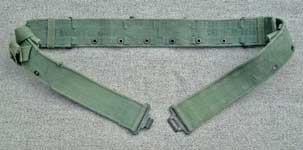
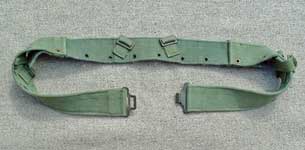 The Belt design was of the three-piece, or Back-Adjustment type. Comment was made that wearers could omit the Strap, back adjustment, as it would have been called, had it been separately coded. This was to cater for those with heat rashes. The lower edge of all sections of the Belt were eyeletted for use with the U.S. style hanger hooks, which were now introduced to British service on the Water bottle carrier and Machete sheath. The Piece, side, right – again not a nomenclature that was used, had a short length of strapping stitched to it, closed with a LTD fastener (Lift The Dot). This rather pointless refinement was intended to secure the butt small of the Rifle, No. 5. It was rarely used, and Belts are often seen with this strap removed. At the rear top edge of each side piece, a small “C” clip was stitched to a chape angled slightly to the rear. The Belt, waist, large, shown at left is maker marked “Bagcraft” and dated 1945. From the Allen Prior Collection. Photographs © Allen Prior, 2010
The Belt design was of the three-piece, or Back-Adjustment type. Comment was made that wearers could omit the Strap, back adjustment, as it would have been called, had it been separately coded. This was to cater for those with heat rashes. The lower edge of all sections of the Belt were eyeletted for use with the U.S. style hanger hooks, which were now introduced to British service on the Water bottle carrier and Machete sheath. The Piece, side, right – again not a nomenclature that was used, had a short length of strapping stitched to it, closed with a LTD fastener (Lift The Dot). This rather pointless refinement was intended to secure the butt small of the Rifle, No. 5. It was rarely used, and Belts are often seen with this strap removed. At the rear top edge of each side piece, a small “C” clip was stitched to a chape angled slightly to the rear. The Belt, waist, large, shown at left is maker marked “Bagcraft” and dated 1945. From the Allen Prior Collection. Photographs © Allen Prior, 2010
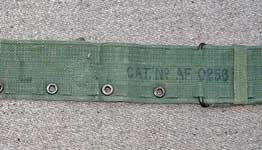 Markings detail of the Belt shown above.
Markings detail of the Belt shown above.
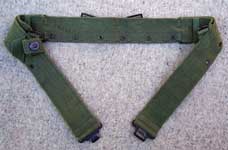
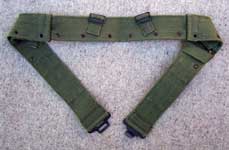
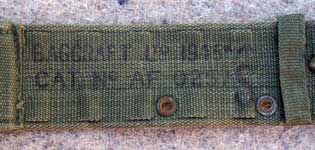 The Fitting Instructions, issued in 1946, list only Large and Normal Belts, however Plate XVII plainly shows a Belt which is coded AF 0257, but marked “S”, for Small. This has recently been corroborated by the Belt at left. It is marked "S" for Small and coded AF 0257. From the David Gordon collection, it is maker marked "Bagcraft Ltd." and dated 1945. Photographs © David Gordon 2009.
The Fitting Instructions, issued in 1946, list only Large and Normal Belts, however Plate XVII plainly shows a Belt which is coded AF 0257, but marked “S”, for Small. This has recently been corroborated by the Belt at left. It is marked "S" for Small and coded AF 0257. From the David Gordon collection, it is maker marked "Bagcraft Ltd." and dated 1945. Photographs © David Gordon 2009.
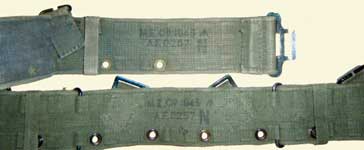 Very quickly, “Small” was revised to read “Normal”, the example here, also dated 1945, now has an “N” marking and comes from the Simon Howlett Collection. This Belt is maker marked "M.E. Co." Photograph © Simon Howlett, 2010. Unlike Patt. ’37, no Extra Large Belt was ever added.
Very quickly, “Small” was revised to read “Normal”, the example here, also dated 1945, now has an “N” marking and comes from the Simon Howlett Collection. This Belt is maker marked "M.E. Co." Photograph © Simon Howlett, 2010. Unlike Patt. ’37, no Extra Large Belt was ever added.
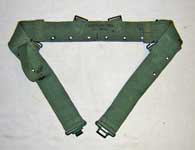
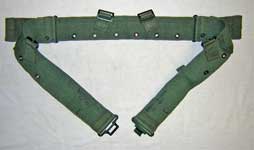
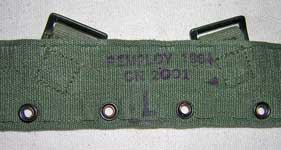 The CN coded Belt, waist, large, shown at left is maker marked "Remploy" and dated 1964. It is from the Karkee Web Collection.
The CN coded Belt, waist, large, shown at left is maker marked "Remploy" and dated 1964. It is from the Karkee Web Collection.
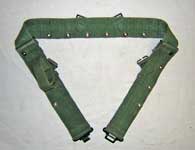
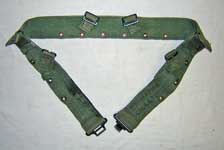
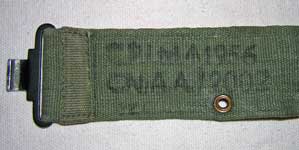 At left is a CN coded Belt, waist, normal. Again from the Karkee Web Collection, this example is maker marked "C.P. Ltd." and dated 1956.
At left is a CN coded Belt, waist, normal. Again from the Karkee Web Collection, this example is maker marked "C.P. Ltd." and dated 1956.
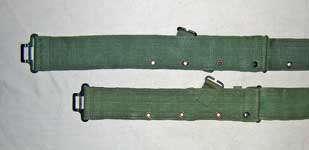
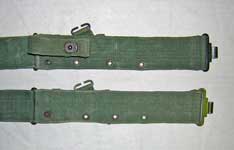 Two interesting comparison photos. Far left, the Left side pieces of Large (top) and Normal (bottom) Belts. These two are the same two CN coded Belts shown above. Nearleft, two Normal Belts. Note that on the lower Belt the short strap intended to hold the rifle butt has been neatly removed, as discussed above. The upper Belt is the C.P. Ltd. (Caoutchouc Products) example previously discussed, whilst on the lower one, also from the Karkee Web Collection, the makers' mark and date are illegible.
Two interesting comparison photos. Far left, the Left side pieces of Large (top) and Normal (bottom) Belts. These two are the same two CN coded Belts shown above. Nearleft, two Normal Belts. Note that on the lower Belt the short strap intended to hold the rifle butt has been neatly removed, as discussed above. The upper Belt is the C.P. Ltd. (Caoutchouc Products) example previously discussed, whilst on the lower one, also from the Karkee Web Collection, the makers' mark and date are illegible.
Later, there were also heavier web versions of both sizes of belt. These are detailed on the NATO (CN coded Equipment) page.
Stores Ref. A6/AF 0258 Braces W.E. Patt. ‘44
Stores Ref. A1/AA 2003 Braces, W.E. Patt. ‘44
Stores Ref. CN/AA 2003 Web Equipment Patt. ’44, Braces
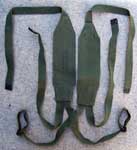
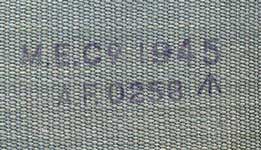
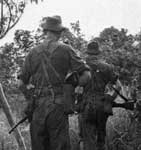 These were radically different to anything Mills had designed in the past. They provided six-point support to the Belt, at front and rear and now at the sides, utilising the “C” clips on the Pieces, side. The Braces were also paired and were inseparable and at last employed a decent bearing surface on the flared sections. At the rear, two straps depended from the flare, the outer pair aligned to secure to the back buckles. The second pair incorporated an adjustment buckle, forming loops which were inserted in the side “C” clips. It was this pair that allowed the strap, back adjustment to be omitted, if required, since the side pieces could still be kept in tension. Unlike other Brace flares, no reduction weaving was used, so even Mills and MW&S employed separate flares in their construction. Collectors often refer to these as a "Yoke", presumably because the two sides are sewn together into a single unit. We've even seen it spelled "Yolk"! However, the correct terminology is Braces. The pair shown here are from the David Gordon Collection. Photographs © David Gordon 2009. At right, a good view of the Patt. '44 Braces worn in action. The Gordon Highlanders on patrol in Malaya, 1954.
These were radically different to anything Mills had designed in the past. They provided six-point support to the Belt, at front and rear and now at the sides, utilising the “C” clips on the Pieces, side. The Braces were also paired and were inseparable and at last employed a decent bearing surface on the flared sections. At the rear, two straps depended from the flare, the outer pair aligned to secure to the back buckles. The second pair incorporated an adjustment buckle, forming loops which were inserted in the side “C” clips. It was this pair that allowed the strap, back adjustment to be omitted, if required, since the side pieces could still be kept in tension. Unlike other Brace flares, no reduction weaving was used, so even Mills and MW&S employed separate flares in their construction. Collectors often refer to these as a "Yoke", presumably because the two sides are sewn together into a single unit. We've even seen it spelled "Yolk"! However, the correct terminology is Braces. The pair shown here are from the David Gordon Collection. Photographs © David Gordon 2009. At right, a good view of the Patt. '44 Braces worn in action. The Gordon Highlanders on patrol in Malaya, 1954.
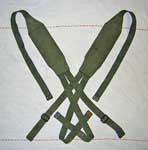
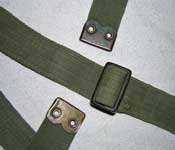
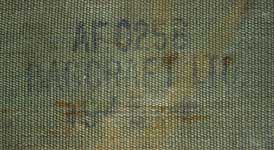 Another interesting pair of Patt. '44 Braces. These are just a bit different - the end tabs are blackened brass and the three-bar buckles are black-painted aluminium. Both types of fittings are more commonly anodised aluminium. From the Karkee Web Collection, they are maker marked "Bagcraft Ltd." and dated 1945.
Another interesting pair of Patt. '44 Braces. These are just a bit different - the end tabs are blackened brass and the three-bar buckles are black-painted aluminium. Both types of fittings are more commonly anodised aluminium. From the Karkee Web Collection, they are maker marked "Bagcraft Ltd." and dated 1945.
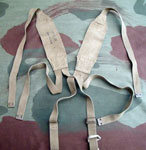
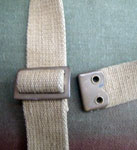
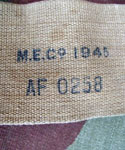 An example of the trials issue of the Patt. '44 Braces. This is the version of the equipment illustrated in the Fitting Instructions. Unlike the production version, this pair of Braces is made of khaki web with plain brass fittings. From the Frank Brown Collection, they are maker marked "M. E. Co." and dated 1945. Photographs © Frank Brown 2015.
An example of the trials issue of the Patt. '44 Braces. This is the version of the equipment illustrated in the Fitting Instructions. Unlike the production version, this pair of Braces is made of khaki web with plain brass fittings. From the Frank Brown Collection, they are maker marked "M. E. Co." and dated 1945. Photographs © Frank Brown 2015.
Stores Ref. A6/AF 0268 Strap, shoulder, haversack, left, W.E. Patt. ‘44
Stores Ref. A1/AA 2014 Strap, shoulder, haversack, left, W.E. Patt. ‘44
Stores Ref. CN/AA 2014 Web Equipment Patt. ’44, Strap, shoulder, haversack, left
Stores Ref. A6/AF 0269 Strap, shoulder, haversack, right, W.E. Patt. ‘44
Stores Ref. A1/AA 2015 Strap, shoulder, haversack, right, W.E. Patt. ‘44
Stores Ref. CN/AA 2015 Web Equipment Patt. ’44, Strap, shoulder, haversack, right
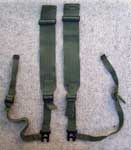
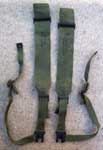
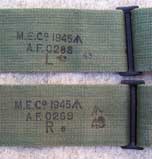 In form these were the Patt. ’37 type, but with additional features. The 1-inch section above the Hook, haversack was adjustable through a QRB. The ¾-inch counter strap was similarly adjustable by a QRB. This allowed a considerable degree of adjustment, without recourse to removing the Haversack to move the strap at either its upper (2-inch tab) or lower (base buckle) attachment points. The Straps could be attached to the Rucksack as well. The pair shown here are from the David Gordon Collection. Photographs © David Gordon 2009.
In form these were the Patt. ’37 type, but with additional features. The 1-inch section above the Hook, haversack was adjustable through a QRB. The ¾-inch counter strap was similarly adjustable by a QRB. This allowed a considerable degree of adjustment, without recourse to removing the Haversack to move the strap at either its upper (2-inch tab) or lower (base buckle) attachment points. The Straps could be attached to the Rucksack as well. The pair shown here are from the David Gordon Collection. Photographs © David Gordon 2009.